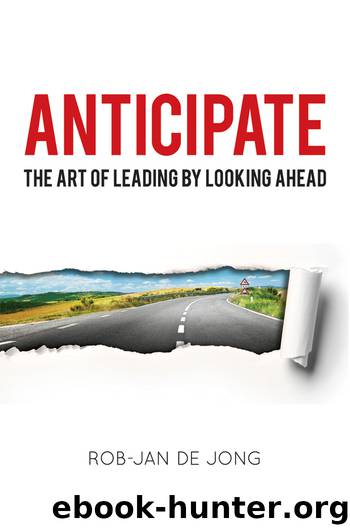Anticipate by Rob-Jan De Jong

Author:Rob-Jan De Jong
Language: eng
Format: epub
ISBN: 9780814449080
Publisher: AMACOM
Published: 2015-07-20T16:00:00+00:00
Figure 5-2. Uncertainty-impact matrix.
With the two axes defined, and the extreme ends of each uncertainty axis labeled, we define four quadrants that, while fundamentally different, are equally plausible. Since we worked with the most impactful uncertainties, they are also of significant interest.
The logic once more: The two uncertainties we’re working with were the most impactful (hence, of significant interest) and the most uncertain (hence, each quadrant could be “reached” in case the uncertainty were to play out in its most extreme form), so collectively, the four quadrants make up four fundamentally different and maximally interesting different future views. And, to the best of our knowledge today, each one is plausible. So, rather than placing our bet on just one of these future outlooks, we’d better understand the logic of all of them.
Let’s use an example to demonstrate. In 2009, I worked with Paul Schoemaker on a scenario-planning exercise aimed at better understanding how the Western world might transform as a result of the financial crisis. The two key uncertainties we identified in our research were 1) the nature of the crisis (from deep, ugly, but essentially cyclic, on the one extreme, to systemic and transformative on the other extreme) and 2) the changing role of government influence (from temporary intervention to pull society through the hardship to a more dirigiste, directive role).
These defined four quadrants (shown in Figure 5-3) each represent a very different outlook. Once you’ve got the quadrants, what’s next? Essentially, you create a story for each outlook (quadrant), starting by giving it a catchy and memorable title. Then you start painting the picture of what the world would look like: What is fundamentally different in terms of economic developments, technology, regulation, social context, and so on? Good questions include: Who are the leading players? What new developments have materialized? What is it that people value? What technologies have emerged? What regulatory changes have taken place? What power balances have shifted?
Download
This site does not store any files on its server. We only index and link to content provided by other sites. Please contact the content providers to delete copyright contents if any and email us, we'll remove relevant links or contents immediately.
Tools of Titans by Timothy Ferriss(7806)
Change Your Questions, Change Your Life by Marilee Adams(7371)
Deep Work by Cal Newport(6562)
Man-made Catastrophes and Risk Information Concealment by Dmitry Chernov & Didier Sornette(5644)
Playing to Win_ How Strategy Really Works by A.G. Lafley & Roger L. Martin(5488)
Digital Minimalism by Cal Newport;(5388)
Big Magic: Creative Living Beyond Fear by Elizabeth Gilbert(5348)
The Slight Edge by Jeff Olson(5199)
The Motivation Myth by Jeff Haden(4997)
Ego Is the Enemy by Ryan Holiday(4950)
Stone's Rules by Roger Stone(4852)
The Laws of Human Nature by Robert Greene(4770)
Tuesdays with Morrie by Mitch Albom(4392)
Rising Strong by Brene Brown(4190)
Eat That Frog! by Brian Tracy(4147)
Skin in the Game by Nassim Nicholas Taleb(3965)
The Money Culture by Michael Lewis(3843)
Bullshit Jobs by David Graeber(3826)
Skin in the Game: Hidden Asymmetries in Daily Life by Nassim Nicholas Taleb(3720)
